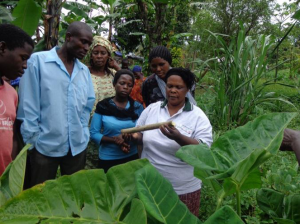
A volunteer farmer trainer in Wakiso district, Uganda, training farmers on planting Gliricidia fodder shrubs from cuttings. Photo credit: Pius Lutakome.
How most efficiently to help farming men and women access information and advice they need to be more effective managers of their enterprises is a puzzle not yet solved. Progress in this area will increase returns to agricultural research, as farmers are more readily able to adopt, and will enhance incomes and well-being. Work led by the World Agroforestry Centre and the International Livestock Research Institute showed that volunteer farmer trainers (VFTs) can be effective agents of change. The results of the studies indicate that VFTs are highly effective, training on average 20 farmers per month. VFTs have an in-depth knowledge of local conditions, culture, and practices; they live in the community, speak the same language, and instill confidence in their fellow farmers, which explains this good performance. VFTs require effective back-up from more fully trained extension agents or subject-matter specialists.
Based on the study results, the East Africa Dairy Development Project (EADD) implemented by Heifer International[1] and funded by the Bill and Melinda Gates Foundation adopted the VFT approach. EADD reaches 315,000 dairy farmers in 4 countries in East Africa. This project is now backstopping over 2,000 VFTs in Uganda and Kenya. The proportion of women farmer trainers in the region went up from 28% in 2008 to 33% in 2011, as compared to less than 10% of female professional trainers and extension staff working on the EADD. The study showed that female trainers are as knowledgeable and effective in reaching farmers as their male counterparts. In Rwanda, the Ministry of Agriculture has adopted the VFT approach and has taken over supervision of 64 of the EADD project’s volunteer farmer trainers. In Kenya, EADD is helping dairy producer organizations to coordinate and backstop VFTs.
This work is part of the CGIAR Research Program on Policies, Institutions, and Markets (PIM) and is co-financed by PIM, FTA, CCAFS, EADD and FoodAfrica, a research project funded by the Finnish Ministry of Foreign Affairs.
Background
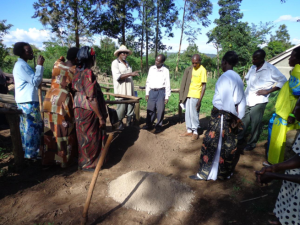
A volunteer farmer trainer in Wakiso district, Uganda, training farmers on establishing a tree nursery. Photo credit: Pius Lutakome.
A decline in public sector extension services in developing countries has led to an increasing emphasis on alternative extension approaches that are participatory, demand-driven, client-oriented, and farmer-led, with an emphasis on targeting women, the poor, and other disadvantaged groups. One such approach is the volunteer farmer trainer (VFT) approach, a form of farmer-to-farmer extension where VFTs host demonstration plots and share information on improved agricultural practices within their community. VFTs are trained by extension staff, and they, in turn, train and share information with other farmers.
While the volunteer farmer trainer approach is not new per se, the authors of the project are among the first to conduct research on the approach across different countries and contexts, to assess its effectiveness and to identify ways to improve it.
How does it work?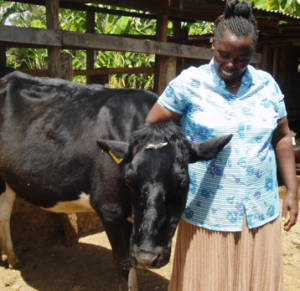
Most of the training on better dairy production is practical and happens on demonstration plots maintained on volunteer farmer trainers’ land. As trainees embrace improved dairy farming methods, the volunteers pay them neighborly visits to check progress and answer questions. Most of the training involves farmers who are members of a dairy group. On average, each volunteer farmer trainer reaches five villages outside of their own, travelling mostly on foot and covering up to 7 km a day.
Why do they join and stay?
What drives farmer trainers to devote their time and energy to this activity, all without drawing a salary?
Our research shows that different farmer trainers have different motivations. When joining, their main motivations are early access to information and technology, altruism, and improved social status and networking. But three years after joining, earning income from selling products and services associated with their training activities also becomes an important motivation. Over half of the farmer trainers in Kenya were earning income from selling fodder seed, planting material or services such as chopping grass using a chaff cutter or preparing silage or hay. Extension providers can make their volunteer farmer trainer programs more effective and sustainable through understanding what motivates their trainers and providing low-cost incentives for keeping them motivated.
"It makes me feel good" (testimonials)
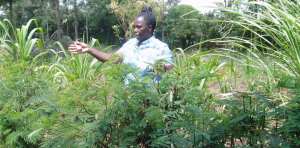
A volunteer farmer trainer in her calliandra and napier grass demonstration plot in Kieni, Kenya. Photo credit: Evelyne Kiptot.
“Seeing other farmers in the community improve their productivity as a result of my training gives me satisfaction. It makes me feel good,” Mrs. Agatha Buuri from Mweiga, Kieni West District in Kenya, told Dr. Evelyne Kiptot, a social scientist with ICRAF involved in the EADD project.
Mrs. Esther Wamucii Wambugu, another volunteer farmer trainer in Mweiga, said results were her source of inspiration, too: “When I see the farmers I have trained increasing their milk production, I get the confidence to train more farmers, because it is a sign that my work is bearing fruit.”
“Service to the community has made me become so famous…wherever I go, farmers refer to me as Mwalimu (Kiswahili for teacher). This recognition has raised my social status,” Mr. Laban Tallam, a volunteer farmer trainer from Kabiyet, Nandi North District in Kenya, told Kiptot.
‘‘The knowledge I have gained has increased productivity and my income. Before I became a VFT, I used to get less than 5 liters of milk in a day, but I now get about 40 liters!’’ - Mrs. Agatha Buuri, Mweiga, Kieni West District.
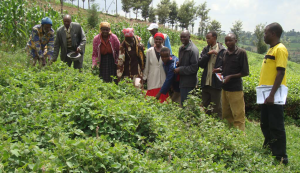
Farmers attending a training session at a farmer trainer’s desmodium demonstration in Longisa, Kenya. Photo credit: Evelyne Kiptot.
‘‘Today I am a trainer on livestock feed technologies. My neighbor may be a trainer tomorrow on another aspect.’’ (VFTs disseminate livestock feed technologies believing that someday their deeds will be reciprocated by other group members). - Mrs. Esther Kenduiywo, Longisa, Bomet District.
‘‘If you have food and your neighbor does not have [food], he will steal it from you. So why not impart skills that can help everyone?’’ - Mr. Tamabut Samoei, Kipkaren, Nandi North District.
“The success of the volunteer farmer trainer approach is changing the way we think about agricultural extension. Here, the farmers themselves are the principal agents of change in their communities, with extension workers serving as facilitators.”
Steven Franzel, leader, Research on Rural Advisory Services at the World Agroforestry Centre (ICRAF).
In what context does the approach work best?
The research also helps extension providers by showing that the volunteer farmer approach is not suitable in all situations. For example, it does not perform well in many areas of low population density, because farmers often lack transportation to visit other farmers. It is also not suitable for complex, high-risk technologies, such as many livestock health or crop protection technologies.
Related links:
Volunteer farmer trainers: improving smallholder farmers’ access to information for a stronger dairy sector (Policy Brief)
Volunteer farmers transforming East Africa's dairy sector (World Agroforestry Centre blog post)
What motivates volunteer farmer trainers? (Agroforestry World Blog)
Volunteer farmer trainers: go or no go? (Agroforestry World Blog)
Voluntarism as an investment in human, social and financial capital: evidence from a farmer-to-farmer extension program in Kenya (Kiptot, E., Franzel, S., 2014. Agriculture and Human Values: 31, 231-243)
Disseminating Improved Practices: Are Volunteer Farmer Trainers Effective? (B. Lukuyu , F. Place , S. Franzel & E. Kiptot (2012). The Journal of Agricultural Education and Extension, 18:5, 525-540)
[1] Heifer is the lead organization in implementation. Other partners in implementation are Technoserve, ILRI, ICRAF, and African Breeding Services Total Cattle Management.



